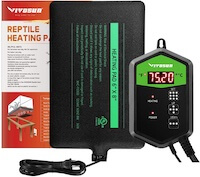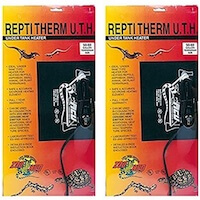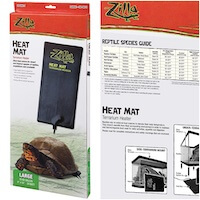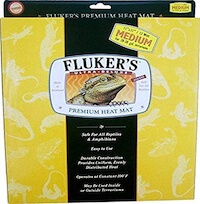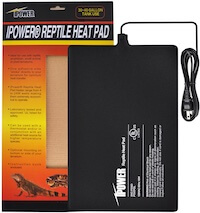Reptiles are ectotherms. This means they always need a good heat source to remain active and healthy. There are several ways to heat a reptile tank. The best options are heating pads (under tank heaters), ceramic heat bulbs and basking bulbs.
Ceramic and basking bulbs provide heat from above, while reptile heating pads heat from below. This means overhead heaters warm air temperature, and heating mats warm the substrate.
There are many factors that go into choosing the best reptile heating pad. Models with thermostat controls are essential. Wattage and mat size are also important factors for a healthier and happier pet reptile.
Continue reading for our list and review of the best heating mats.
Vivosun’s heat mat and digital thermostat combo is a great choice for 30-gallon tanks. It has a strong adhesive grip and is waterproof for cleaning. The thermostat provides a high degree of temperature control and is easy and simple to use.
5 Best Reptile Heating Pads
The best under tank heaters all have thermostats or fail-safe shutoff systems to prevent overheating.
Good heating pads should also be made specifically for reptiles and provide a constant source of heat with minimal fluctuations. They should use less electricity than a ceramic heater and come with an adhesive panel for easy installation.
| Editor’s Picks | Heater | Our Rating |
|---|---|---|
| Best Overall | VIVOSUN Reptile Heat Pad | 5 |
| Best for Large Tanks | Zilla Large Heat Mat | 4.8 |
| Runner-Up | Zoo Med Under Tank Heater | 4 |
| Most Affordable | Fluker’s Reptile Heating Pad | 4.2 |
Best Overall: VIVOSUN Reptile Heat Pad
Vivosun’s heat mat and digital thermostat combo is a great choice for 30-gallon tanks. It has a strong adhesive grip and is waterproof for cleaning. The thermostat provides a high degree of temperature control and is easy and simple to use.
The VIVOSUN Reptile Heat Pad is the only heat pad on our list that comes with a thermostat and temperature probe. This thermostat allows you to easily adjust the heater’s output from 40 to 108°F.
This heater’s temperature controller is the best feature. It allows you to easily control the heater’s output while also providing an emergency shutoff system in case of malfunction.
The 6” x 8” model is perfect for a 20-gallon terrarium, while the 8” x 12” model is perfect for a 30-gallon tank. Both models are great for all tropical, temperate and desert reptiles.
It is suitable for any glass terrarium and is easy to fit. Once installed, the adhesive backing ensures direct heat transmission, but it cannot be removed or repositioned.
This heater is also waterproof (for cleaning purposes only). It should not be submerged!
A downside of this model is that it can take longer than five hours to reach the target temperature. We discovered that the mat took 12 hours. This does not impact the heater’s performance, but it can influence how soon a setup will be ready.
Overall the VIVOSUN Reptile Heat Pad is an excellent choice for either 20-gallon or 30-gallon tank.
Pros:
- Great for a 20-gallon or 30-gallon tank.
- Comes with a thermostat and temperature probe for easy control.
- Heating mat is waterproof for easy cleaning.
- Adhesive side for quick and easy installation.
- Suitable for all reptile species.
Cons:
- Takes several hours to fully heat.
- Adhesive backing cannot be removed or repositioned.
Runner-Up: Zoo Med Under Tank Heater
This reptile heat mat is a great choice for a lower-power heating pad. This medium-sized mat comes with an adhesive backing for easy installation and is great for a 30-gallon tank.
The Zoo Med reptile heater is the perfect heat mat for a 30-gallon glass tank. It measures 8 inches by 15 inches.
This heater is designed with a permanent adhesive side which makes installing it on the side or bottom of a glass tank easy. The adhesive also allows for maximum heat exchange efficiency. Unlike cheaper heaters, this model is also designed to heat for 24 hours a day. It has a reliable, solid nichrome heating element.
The surface of this heater does not exceed 100°F, so it is ideal for reptiles like fence lizards, rat snakes, corn snakes, copperheads, and king snakes. It may not be suitable for species that like extreme hot spots.
We love that this heater comes with two heat pads. These mats can be used on separate tanks or the same tank. Using two mats on the same tank can help you create a higher temperature gradient.
While it does not come with built-in temperature control, it can be plugged into an external thermostat, rheostat, or timer.
Overall, this is an excellent heating pad for a 30-gallon tank, especially one housing a reptile that does not need surface basking temperatures above 95°F.
Pros:
- Great for a 30-gallon tank.
- Adhesive side for easy installation.
- Suitable for species that do not need surface basking temperatures above 95°F.
- Two heat pads can be used to create a higher temperature gradient.
Cons:
- Not enough wattage for a desert reptile.
- Not waterproof, making it difficult to clean the outside of the tank.
- Does not come with thermostat.
Best for Large Tanks: Zilla Large Heat Mat
Zilla’s large heat mat is perfect for tanks between 30 and 50-gallons. It puts out heat between 85°F and 113°F, has an automatic safety shut-off, and comes with adhesive backing for easy installation.
The Zilla Large Heat Mat is the largest pad in our list measuring 8.5” x 20”. It is great for 30, 40 and 50-gallon tanks. This heater is excellent at maintaining a steady, high temperature with no fluctuations or declines in temperature.
Its carbon fiber construction means that it can reach a maximum temperature of 113°F, though 105°F is the average. It also has a built in automatic safety shut-off if it gets hotter than 113°F.
Unlike alloy or nichrome heating elements, carbon fiber does not use wires within the heater. This means it cannot be pinched or broken during installation. However, because of the carbon fiber element, it is slightly thicker than other heaters.
Unfortunately, Zilla’s adhesive is not quite strong enough to hold up such a larger heater. We had to reinforce it with packing tape.
Adhesion problems aside, we highly recommend this heater.
It is a high-quality heating mat that can easily put out heat between 85°F and 113°F in larger 50-gallon tanks. It is also a nice size for horizontal tanks and can be placed on the back or sides.
Pros:
- Great for a 40 or 50-gallon tank.
- Free from internal wires that can be pinched or broken.
- Even, consistent heat distribution and a good temperature range (between 85°F and 113°F).
- Automatic safety shut-off to prevent temperatures above 113°F
Cons:
- Adhesive backing may not hold the heater against the tank properly.
- Does not come with thermostat.
Most Affordable: Fluker’s Reptile Heating Pad
This Fluker’s heat mat is a powerful, medium-sized under tank heater that efficiently heats up to 105°F. We love the design and power of this heater. It does not come with adhesive backing, but this makes it easy to reposition as many times as you want.
The Fluker’s Reptile Heating Pad is one of the best entry-level heaters available. The heater is 11” x 11” and is a very affordable choice for a 20 or 30-gallon terrarium.
A unique feature of Fluker’s pad is that it does not have an adhesive back for installation. Instead, it should be secured to the glass with electrical or packing tape.
We love this feature because it can be moved without damaging the tank or heater. This allows you multiple attempts to find the best position for the heat gradient without worry. Like all heating pads, it should be placed on the outside bottom or side of the tank.
It is water resistant, but not water proof. Try to minimize any exposure to liquid when cleaning.
This heater took six hours to reach its maximum temperature of 105°F. Under a thin layer of substrate (about an inch), the heater reached 105°F at its center and 80°F around the edges
A disadvantage of the Fluker’s Reptile Heating Pad is its paper-thin design. This means it will fit under every tank, but it also has a higher risk of being damaged from accidental folding or creasing.
This heating pad is not waterproof and it does not have a digital thermostat like more expensive models. However, is the best entry-level heater and is perfect for 20 or 30-gallon terrariums.
Pros:
- Great for a 20 or 30-gallon tank.
- Lack of adhesive means it can be removed and repositioned easily.
- Heats up to a steady temperature of 105°F within six hours.
Cons:
- Must be secured with electrical or packing tape.
- Higher risk of creasing or bending due to very thin design.
- Does not come with thermostat.
Budget Runner-Up: iPower Reptile Heat Pad
iPower’s under tank heater is an economical choice for a strong and sturdy reptile heat mat. It has the strongest adhesive of any other mats on our list and heats up within an hour.
The iPower Reptile Heat Pad is another fantastic budget-range heater. This 8” x 12” model uses 16 watts and works well in a 30-gallon terrarium.
For installation the pad is secured with a heat strength 3M glue panel. This panel is the strongest of all mats we tested. However, it does mean that you cannot remove this heater once installed.
This heater is covered with a thick insulation to facilitate quick and efficient heat transfer. Unfortunately, this insulation means the pad is thick and can get too hot without a thermostat. The benefit of insulation means this heater reaches 104°F in under one hour.
It does not come with a thermostat, but it does have a 6-foot-long electrical cord for easy access to an outlet. The mat is also waterproof for cleaning and is resistant to bending.
This reptile heater is an excellent budget model. We loved its tough design, strong adhesive, and quick heating.
Pros:
- 8” x 12” model is great for a 30-gallon tank.
- 3M glue panel is the strongest of all mats we tested.
- Heats up to 104°F in under one hour.
- Has 6-foot-long electrical cord for easy access to an outlet
Cons:
- Pad is thick and can get too hot without a thermostat.
- It does not come with a thermostat.
- Lacks an in-built automatic safety shut-off.
What To Know Before Buying Reptile Heat Pads
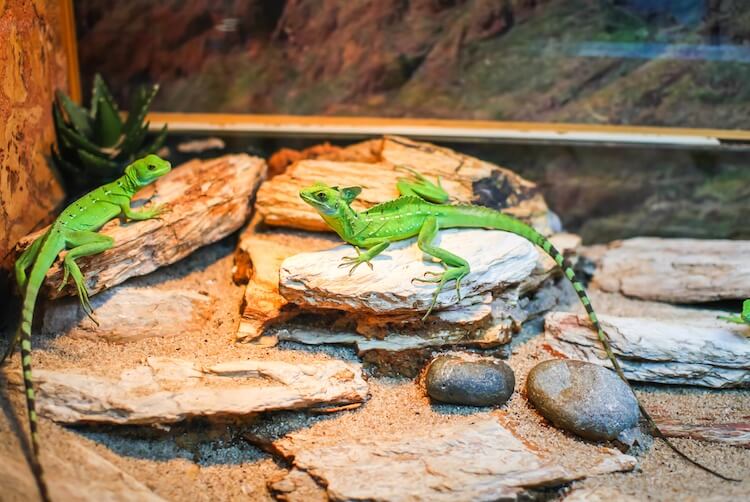
Heating pads are an important part of any reptile terrarium setup. They provide a steady source of direct heat for your reptile which is vital for its health and survival.
Heaters are important for any reptile’s survival but can be dangerous if misused.
Some heat mats are designed for just wattage and power. You need to consider the safety and effectiveness of each heater.
It is important to know heat mats vary in quality, wattage, output and features.
All good heaters, including those we reviewed above, should be:
- Specifically made for reptiles.
- Thermostat ready or have an automatic safety shut off.
- Have a wattage between 4 watts and 24 watts.
Made For Reptiles
We recommend that you only buy reptile heating pads that are specifically made for lizards, snakes, or turtles. These heaters are normally pre-configured to stay within a safe temperature range. They are also configurable based on their wattage and size.
Some experienced keepers use heat tape instead of heating pads.
Though less expensive, heat tape can quickly become too hot for reptiles. It also does not have the option to use a thermostat, making it riskier. Reptile heaters may be more expensive, but they are also safer, sturdier and longer lasting than heat tape.
There are also heating pads and tapes that are meant for industrial work. These heaters are much cheaper, but they get too hot for a reptile. They also cannot be connected to a thermostat and are less precise in their heat output
Heating pads for reptiles usually get no hotter than 120°F, most reach 90-105°F. Under tank heat mats raise the ambient temperatures of a tank by 15°F. Industrial heaters can reach over 200°F.
Thermostat Ready
Thermostats are generally purchased separately from a heat mat, but your mat should be able to be plugged into an external thermostat, rheostat, or timer.
A thermostat will automatically shut off your under tank heater if it exceeds a temperature. This is an important safety feature that will keep your reptile from getting burned if the heating pad malfunctions.
Some heating pads are also compatible with a rheostat.
As opposed to a thermostat, a rheostat does not switch off the heater. Instead, it directly alters the heater’s power back to a safe level. It works as a ‘dimmer switch’ to increase or decrease a heater’s temperature output.
Non-programmable heating pads run the risk of not shutting off in an emergency.
Wattage
The wattage of a heat pad determines how hot it will get.
Reptile heating pads run from 4 watts to 24 watts, depending on the size of the heater and the voltage it requires. Larger heaters are almost always hotter than smaller ones, though there are exceptions.
The size of your tank will determine the wattage you need.
Using a reptile heating pad with too high or too low wattage leads to improper temperatures in your reptile’s terrarium. Chronically low temperatures can cause sluggishness, digestion problems and shedding problems.
Tank overheating can cause dehydration, and respiratory infections.
Use our tank size guide below to choose the proper wattage heater for your size tank.
| Tank Size | Wattage |
|---|---|
| 10-gallon | 4 Watts |
| 20-gallon | 8 Watts |
| 30 or 40-gallon | 16 Watts |
| 50 or 60-gallon | 24 Watts |
What Size Under Tank Heater Do You Need?

The size of your reptile heating pad vs. the size of your terrarium will determine its effectiveness.
As a general rule of thumb, you should purchase a heat mat that is one third the size of your terrarium’s floor area. This will provide a “hot spot” for your reptile, as well as create a heat gradient for temperature regulation.
For standard size tanks, here are our suggested heat pad sizes:
| Tank Size | Pad Size | Wattage |
|---|---|---|
| 10-gallon | 4” x 5” | 4 Watts |
| 20-gallon | 6” x 8” | 8 Watts |
| 30 or 40-gallon | 8” x 12” | 16 Watts |
| 50 or 60-gallon | 8” x 18” | 24 Watts |
A heating pad that is too small will not create a sufficient temperature gradient, no matter the wattage. Likewise, a pad that is too large will overheat a smaller tank. You want to create a heat gradient in your tank with a warm and cool side.
Reptile heating pads should be placed on the hot side of the enclosure, on the outside of the bottom of the tank.
Some types of Chameleon species that live in tall tanks may need a heater on the side of the terrarium, but most pet lizards prefer a heater on the bottom of the tank.
Summary
Reptile heating mats are important for a reptile’s husbandry and health. They are a safe and efficient way to heat a tank, but not all under tank heaters are the same.
Look for a heating mat that is made for reptiles, compatible with a thermostat, and the right size and wattage for your tank. Most heating pads cannot be removed or repositioned once placed, so take the time to consider what brand and size would be best.
The five heaters included in this article are all excellent choices for owners with different budgets and species of reptile.
What reptile heating pad do you use? Let us know in the comments below.
As an Amazon Associate I may earn a small commission from qualifying purchases (learn more here).

